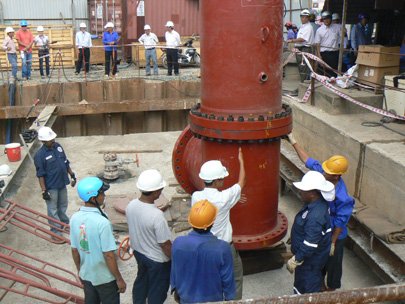
A water pipe installation in HCMC.
This is a highlight in HCMC’s water supply plan between now and 2020 that was approved by the Deputy Prime Minister Hoang Trung Hai on Tuesday.
Under the plan, the city will construct a water pipeline stretching from Tri An Lake to the water plants which treat water from the Dong Nai river and a similar system to bring water from Dau Tieng Lake to the water plants which use water from the Saigon River.
The upstream irrigation system must meet stringent requirements of the lake regulation system, especially in dry season, in order to maintain the quality and water flow for stable supply. The city must launch tight inspections to control river and lake pollution.
Most of the city’s existing water treatment plants such as Thu Duc, Thu Duc BOO, Binh An, Tan Hiep 1 treat water pumped from Dong Nai and Saigon Rivers. In near future, the city will regulate 2.5 million cubic meters from Tri An Lake and 1 million cubic meters from Dau Tieng and Phuoc Hoa lakes to feed new water supply utilities.
The central Government will pump VND68 trillion into the city’s water supply development plan. In particular, new water plants comprising Thu Duc 3 and Tan Hiep and a water supply system expansion project will be first financed with VND15 trillion.
The city will also upgrade pipelines to reduce water losses.
As for underground water, the city will pump it on a large scale with a daily capacity of 100,000 cubic meters.
The city’s total running water output is 2.2 million cubic meters per day. The figure is forecast to increase to nearly 2.8 million cubic meters by 2015 and 3.7 million cubic meters by 2025 with a water loss ratio of 25%.
SGT